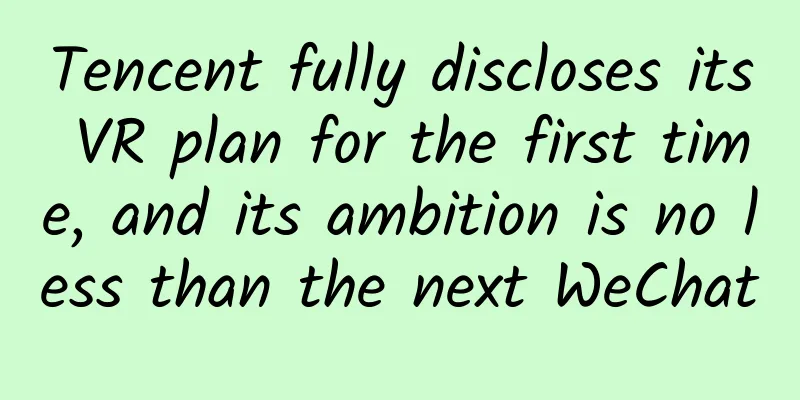Tencent fully discloses its VR plan for the first time, and its ambition is no less than the next WeChat

|
In the relatively "chaotic" and stalemate virtual reality market in China, a big player is finally going to make a move. On the afternoon of December 21, Tencent officially announced the Tencent VR SDK and developer support plan at the Tencent VR Developer Salon held in Beijing, systematically expounding on Tencent’s plans in the field of virtual reality for the first time. For this Internet giant, WeChat, which already has 650 million users, has given it an advantage in the mobile Internet era. As the global technology community recognizes that virtual reality technology is the next wave of technological innovation and a trillion-dollar market, it is becoming the focus of competition in the industry. While Facebook, Google and domestic startups that have sprung up like mushrooms after rain have all been involved in it, BAT has been quite "calm" in the past period of time. Tencent's public plan this time is also the first big move made by BAT in the field of virtual reality. In fact, in Zhidongxi's view, Tencent is making the vague business story of virtual reality clearer. Once it takes root and matures, its strategic significance to Tencent will be no less than the next WeChat. Tencent's VR Ecosystem Blueprint Currently, virtual reality products include three solutions: PC consoles represented by Oculus VR, game consoles represented by Sony PS VR, and mobile devices represented by Samsung Gear VR. The advantages of the former two are high performance, but are limited by usage scenarios and prices; the advantages of the latter are low cost and portability, but there are major obstacles in terms of performance and heat dissipation.
According to Tencent's plan, Tencent VR will support the above three product forms at the same time: In March 2016, the company launched a head-mounted display (HMD), or DK, that integrates sensors and a dedicated screen. It was provided to partners as a virtual reality development platform in conjunction with Tencent's first-generation miniStation micro-game and PC through HDMI and USB interfaces. In the third quarter of 2016, a portable console-style head-mounted display device with a battery, namely CV, will be launched; with the somatosensory handle, it will provide a virtual reality solution similar to PS VR. At the same time, the consumer version may also be launched in the second half of the year. In the third quarter of 2017, based on the mature content ecosystem and technology, we will develop mobile VR and all-in-one solutions, or launch products similar to Gear VR. According to Li Shuxin, technical director of Tencent Intelligent Device Innovation Center, the special architecture of the virtual reality system means that the design of content no longer needs to rely on the hardware itself, but relies on a public development platform, and most of them are directly developed using game engines. Based on this, the Tencent VR SDK provided by Tencent is also a general solution that connects multiple fields - based on the Unity and Unreal game engines, the Tencent VR SDK components cover rendering, audio and video, input (wired control, game controller and 3D somatosensory controller), account, payment and other aspects. However, Tencent’s construction of Tencent VR SDK was not accomplished overnight, but adopted a three-step strategy: SDKv1: With experience as the core, it provides multiple plug-ins including binocular camera, collision detection, sorting and handle input, 3D video, etc. to help developers quickly develop virtual reality applications. At the same time, it imports Tencent accounts and payment systems including QQ and WeChat. SDKv2: With interconnection as the core, it provides enhanced components around human interaction, including virtual human body data, currency and settlement system, dynamic personal expression, space sharing, etc., to help developers design applications with more forms of interaction between users. SDKv3: With creation as the core, it helps developers build a virtual world rather than just separate applications, in which different application scenarios can be interconnected. What can Tencent give to developers? Backed by Tencent's resources, Tencent VR, as the latest member of many domestic virtual reality platforms or ecosystems, has drawn a huge pie for developers - the developer support plan. In addition to introducing overseas blockbusters, developer activities, providing early investment, virtual reality content incubators and other macro-level support, what developers are most concerned about is obviously the tangible benefits that Tencent VR can bring. First, there is the developer version of Tencent VR provided by Tencent. The entire kit consists of 3 main parts: 1. miniStation micro game console and PC equipment; 2. A set of head-mounted display devices with USB and HDMI interfaces, a small wired control device with a joystick, and also supports standard wireless controllers; 3. We will subsequently develop somatosensory control handles that are compatible with traditional handles, which will be mainly provided to partners who develop somatosensory interactive content. Based on this, Tencent VR has also established a five-level developer rating system to provide targeted support. In addition to the equipment, the important thing is the profit sharing. The picture above is the developer commercial profit-sharing plan announced by Tencent. With its huge resources in social, game platforms, and advertising, Tencent VR provides four profit-sharing models. VR Store (APP): paid download, in-app payment, excellent content support program; Game: payment model for download, payment model for duration, payment model for game props; Video/Cinema: copyright content distribution, PGC content pay-per-demand model, UGC content pre-roll advertising; Advertising: GuangDianTong advertiser resource import, different forms of profit-sharing mechanisms and traffic main models. Tencent's new chess game Obviously, Tencent VR is not planned on the same dimension as many current hardware products, but is trying to focus on being a platform. At the scene, the relevant person in charge of Tencent told Zhidongxi (public account: zhidxcom) that Tencent's involvement in the field of virtual reality is not to create a new hardware brand, but to integrate with Tencent's content resources to provide an adaptive user experience. "We hope that developers can have direct interaction with users, but the current products are difficult to meet our needs, so it is imperative to do this." At the same time, it also confirmed that Tencent will not make hardware by itself for the time being, but will be responsible for the product's interactive design and application system and hand it over to hardware manufacturers for manufacturing. The cooperation strategy is open. "To make a hit product, this model is not Tencent's style." In addition, the above-mentioned person also revealed that Tencent VR is currently importing support for QQ and WeChat SDK, but it is not a direct connection. In fact, from joining hands with Google to invest in Altspace VR, a US virtual reality startup, in September last year, to Ren Yuxin, the COO of Tencent and president of the Mobile Internet Group (MIG) and Interactive Entertainment Group (IEG) in April this year, announcing the "TOS+ strategy" including virtual reality technology, to the official release of its own virtual reality game ecosystem strategy last month, and the launch of a global developer recruitment plan. Tencent has been preparing for its layout in the field of virtual reality for a long time, and we can also see Tencent's views on its development direction, namely the five major areas of games, videos, social networking, live broadcasts and maps, which are strongly related to Tencent's core businesses. In today's opening speech, Li Shuxin also repeatedly mentioned the necessity of Tencent's layout in this field. Will Tencent be the vacant benchmark? Globally, there are many technology giants betting on virtual reality, but the market structure has not yet been established. In China, apart from Tencent, the other two companies of BAT (including the broader "BAT3M") are still vague in their layout in the field of virtual reality; the existing players in the market are mainly second- and third-tier Internet companies and startups, whose user base is not enough to generate sufficient momentum in the industry. Overseas, the relevant persons in charge of Sony PS VR and HTC Vive were also very secretive about entering China in an interview with Zhidongxi (public account: zhidxcom), and although Facebook's Oculus has reportedly registered a company in the Shanghai Free Trade Zone, its specific consumer-grade products will not be available until the first quarter of next year. In fact, the virtual reality market currently lacks a benchmark platform representative that can lead the development direction of the entire industry. Here, it is difficult for us to say that Tencent's Tencent VR will become the leader. Its overall strategy is not to become a pole at the hardware level but to operate a content ecological platform. But it is undeniable that the entry of such a giant will inject a considerable impetus into the domestic virtual reality market. |
<<: iOS view, exploration of animation rendering mechanism
Recommend
Introduction to six recommended Android open source frameworks
1. Volley Project address: https://github.com/sma...
NetEase Tushou PK Yunji Weidian, which social e-commerce is better?
Recently I took over a distribution project, whic...
Note to developers: Android M's permission mechanism
Introduction Before the release of Android M, the...
It turns out that animals also like to dip dumplings in vinegar? Why?
You have to dip dumplings in vinegar when eating ...
The Art of War 100 episodes cartoon video
This course has made 100 famous events in history...
A scientific guide to postpartum confinement. Mothers recover quickly and suffer less. Teach you how to have a scientific confinement
A scientific guide to postpartum confinement. Mot...
Quick application development optimization tips
In March 2018, nine major mobile phone manufactur...
Postpartum body shaping and slimming "Muquan 4+3 system course"
Muquan 4+3 Postpartum Body Shaping and Weight Los...
Facebook Advertising Guide!
If your issue is that your ads aren't serving...
The strange "Swallow in the Stone", is it a bird or a stone?
In the Paleozoic Era, there was a thriving class ...
Don’t feed them blindly! The more you eat, the better the “nutritious meal” of crops
As the saying goes, "Man is iron, rice is st...
Thunderstorms have occurred frequently in the south recently! How to avoid danger when encountering thunderstorms?
□ Luo Mingjun Recently, thunderstorms have occurr...
The core methodology of merchant self-broadcasting operation, a set of practical methodologies
The core methodology of the merchant's self-b...
How to promote products to gain more users and traffic?
An old friend of mine from the media industry sta...
Small but different Xiaomi 40-inch TV Xiaomi TV 2 first experience
At the beginning of this year, the appearance of ...


![[Practical Collection] A comprehensive list of efficient tools necessary for operating Meow and Market Wang](/upload/images/67cc31a3d949c.webp)






